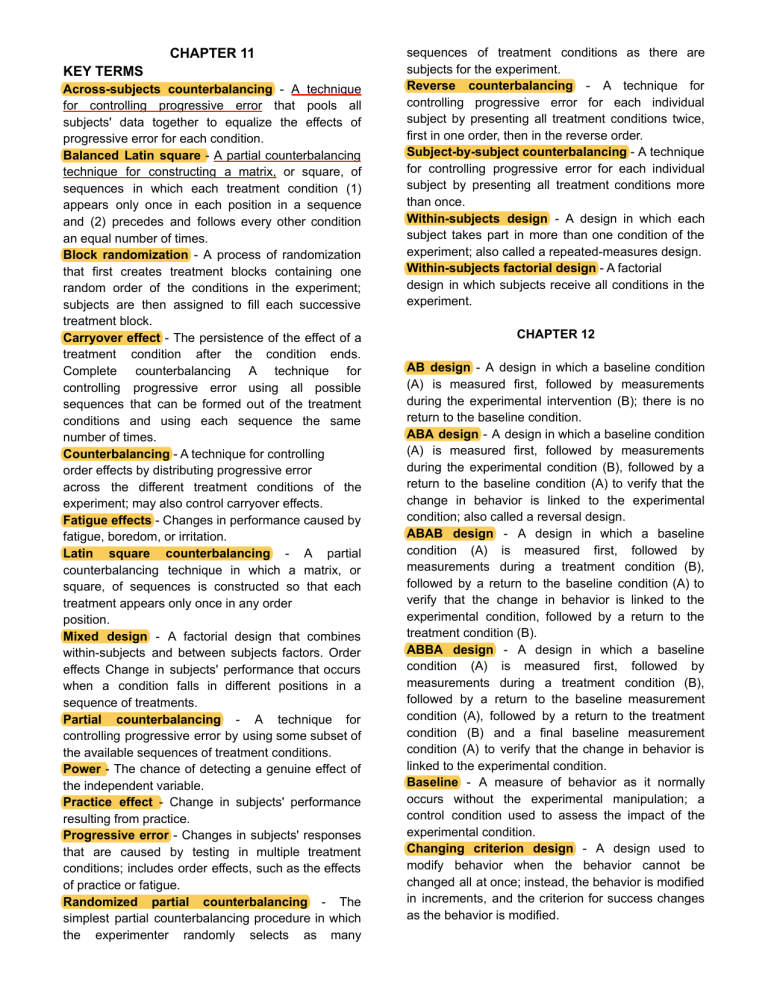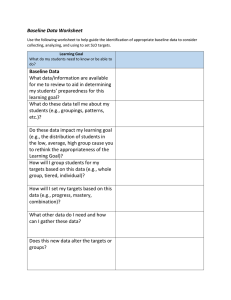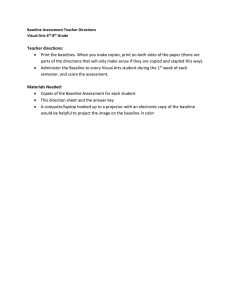
CHAPTER 11 KEY TERMS Across-subjects counterbalancing - A technique for controlling progressive error that pools all subjects' data together to equalize the effects of progressive error for each condition. Balanced Latin square - A partial counterbalancing technique for constructing a matrix, or square, of sequences in which each treatment condition (1) appears only once in each position in a sequence and (2) precedes and follows every other condition an equal number of times. Block randomization - A process of randomization that first creates treatment blocks containing one random order of the conditions in the experiment; subjects are then assigned to fill each successive treatment block. Carryover effect - The persistence of the effect of a treatment condition after the condition ends. Complete counterbalancing A technique for controlling progressive error using all possible sequences that can be formed out of the treatment conditions and using each sequence the same number of times. Counterbalancing - A technique for controlling order effects by distributing progressive error across the different treatment conditions of the experiment; may also control carryover effects. Fatigue effects - Changes in performance caused by fatigue, boredom, or irritation. Latin square counterbalancing - A partial counterbalancing technique in which a matrix, or square, of sequences is constructed so that each treatment appears only once in any order position. Mixed design - A factorial design that combines within-subjects and between subjects factors. Order effects Change in subjects' performance that occurs when a condition falls in different positions in a sequence of treatments. Partial counterbalancing - A technique for controlling progressive error by using some subset of the available sequences of treatment conditions. Power - The chance of detecting a genuine effect of the independent variable. Practice effect - Change in subjects' performance resulting from practice. Progressive error - Changes in subjects' responses that are caused by testing in multiple treatment conditions; includes order effects, such as the effects of practice or fatigue. Randomized partial counterbalancing - The simplest partial counterbalancing procedure in which the experimenter randomly selects as many sequences of treatment conditions as there are subjects for the experiment. Reverse counterbalancing - A technique for controlling progressive error for each individual subject by presenting all treatment conditions twice, first in one order, then in the reverse order. Subject-by-subject counterbalancing - A technique for controlling progressive error for each individual subject by presenting all treatment conditions more than once. Within-subjects design - A design in which each subject takes part in more than one condition of the experiment; also called a repeated-measures design. Within-subjects factorial design - A factorial design in which subjects receive all conditions in the experiment. CHAPTER 12 AB design - A design in which a baseline condition (A) is measured first, followed by measurements during the experimental intervention (B); there is no return to the baseline condition. ABA design - A design in which a baseline condition (A) is measured first, followed by measurements during the experimental condition (B), followed by a return to the baseline condition (A) to verify that the change in behavior is linked to the experimental condition; also called a reversal design. ABAB design - A design in which a baseline condition (A) is measured first, followed by measurements during a treatment condition (B), followed by a return to the baseline condition (A) to verify that the change in behavior is linked to the experimental condition, followed by a return to the treatment condition (B). ABBA design - A design in which a baseline condition (A) is measured first, followed by measurements during a treatment condition (B), followed by a return to the baseline measurement condition (A), followed by a return to the treatment condition (B) and a final baseline measurement condition (A) to verify that the change in behavior is linked to the experimental condition. Baseline - A measure of behavior as it normally occurs without the experimental manipulation; a control condition used to assess the impact of the experimental condition. Changing criterion design - A design used to modify behavior when the behavior cannot be changed all at once; instead, the behavior is modified in increments, and the criterion for success changes as the behavior is modified. Discrete trials design - A design that relies on presenting and averaging across many, many experimental trials; repeated applications result in a reliable picture of the effects of the independent variable. Large N design - A design in which the behavior of groups of subjects is compared. Multiple baseline design - A small N design in which a series of baselines and treatments are compared; once established, however, a treatment is not withdrawn. Small N design - A design in which just one or a few subjects are used; typically, the experimenter collects baseline data during an initial control condition, applies the experimental treatment, then reinstates the original control condition to verify that changes observed in behavior were caused by the experimental intervention.


